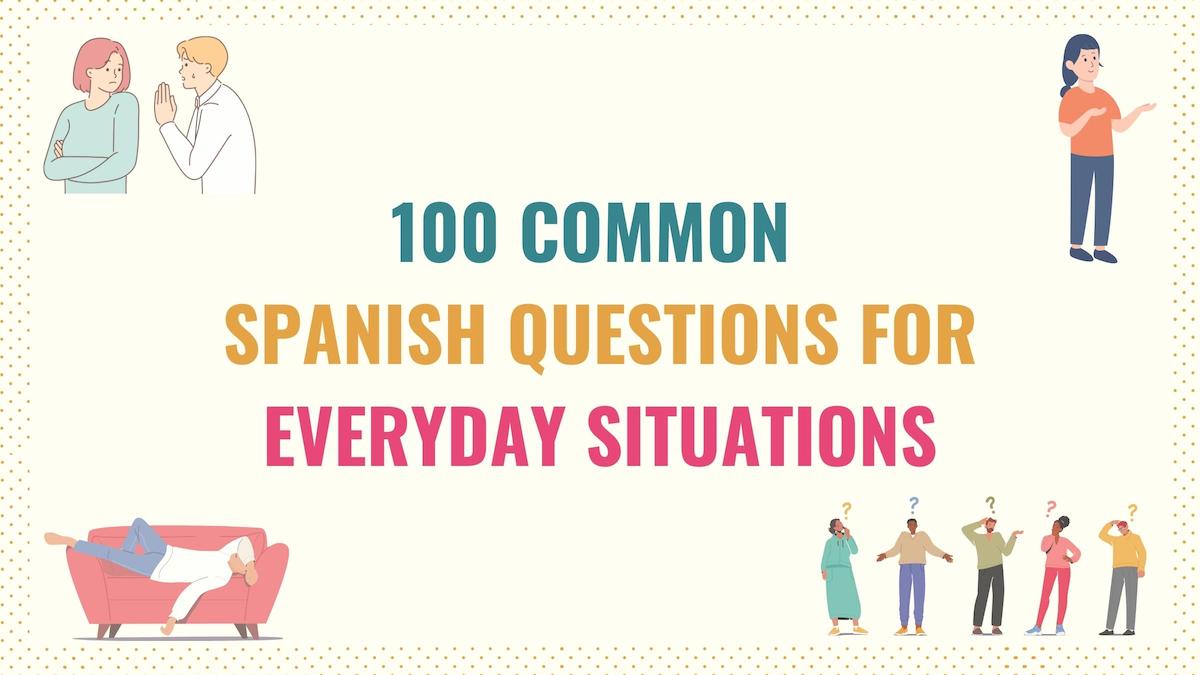Knowing basic Spanish questions is an essential skill for effective communication. As a result, I’ve compiled a list of questions you can use in everyday situations. From essential contexts to getting to know someone, you’ll learn what questions to ask in various situations. Here is a quick overview of this guide:
- Everyday Questions
- Common Questions about the Weather
- Questions about Food
- Get-to-Know-You Questions
- What to Do Next
On top of including basic questions in Spanish, I’ll also include examples of how to answer some of these inquiries.
Basic Questions in Spanish for Everyday Situations
Below you’ll find a list of basic questions in Spanish that can come in handy in everyday situations where you need to engage with other speakers:
- ¿A dónde vas? – Where are you going?
- ¿A qué hora es…? – What time is the…?
- ¿A qué hora abren? – What time do they open?
- ¿A qué hora cierran? – What time do they close?
- ¿A qué hora llegas? – What time do you arrive?
- ¿Acepta tarjetas? – Do you take cards?
- ¿Cómo dices? – What’s that? / What did you say?
- ¿Cómo dormiste?– How did you sleep?
- ¿Cómo estás? – How are you?
- ¿Cómo hiciste esto? – How did you do that?
- ¿Cómo se dice…? – How do you say …?
- ¿Cómo te sientes? – How are you feeling?
- ¿Cómo va tu día? – How is your day going?
- ¿Cuál es el problema? – What’s the matter?
- ¿Cuánto cuesta…? – How much is…?
- ¿Cuánto es? – How much is it?
- ¿De quién es esto? – Whose is this?
- ¿Dónde está…? – Where is…?
- ¿En qué piensas? – What’s on your mind?
- ¿Está bien? – Is this okay? / Are you okay?
- ¿Estás de acuerdo? – Do you agree?
- ¿Estás listo? – Are you ready?
- ¿Está ocupado? – Is this seat taken?
- ¿Hablas español? – Do you speak Spanish?
- ¿Me lo puedo probar? – Can I try it on?
- ¿Me puede ayudar? – Can you help me?
- ¿Me puede hacer un favor? – Can you do me a favor?
- ¿Le puedo ayudar? – Can I help you?
- ¿Lo puedo probar? – Can I try it?
- ¿Por dónde está…? – Which way is…?
- ¿Por qué no? – Why not?
- ¿Puedo abrir una ventana? – Can I open a window?
- ¿Puede hablar más despacio? – Can you speak slower?
- ¿Qué día es hoy? – What day is today?
- ¿Qué dijo? – What did you say? (formal)
- ¿Qué dijiste? – What did you say? (informal)
- ¿Qué es eso? – What is that?
- ¿Qué haces? – What are you doing?
- ¿Qué hora es? – What time is it?
- ¿Qué se le ofrece? – What can I do for you?
- ¿Qué significa…? – What does…mean?
- ¿Qué vas a hacer? – What are you going to do?
- ¿Sabe si hay algún/alguna…por aquí? – Do you know if there is …around here?
- ¿Tienes cambio? – Do you have change?
Here are some examples of some of these questions and their answers:
| Question | Answer |
|---|---|
| ¿Qué hora es? What time is it? | Son las dos y media. It’s two thirty. |
| ¿Dónde está el baño? Where is the bathroom? | El baño está al fondo a la derecha. The bathroom is at the back and to the right. |
| ¿Cuánto cuesta el pan? How much is the bread? | El pan cuesta 30 pesos. The bread is 30 pesos. |
| ¿A qué hora cierran la tienda? What time does the store close? | Cierran a las 8. They close at 8. |
Common Spanish Questions about the Weather
Common questions to ask in Spanish are often related to the weather. Here are some questions you can use for these types of interactions:
- ¿A cuánto estamos hoy? – What is today’s temperature?
- ¿Crees que llueva? – Do you think it’s going to rain today?
- ¿Cómo es el clima en…? – How is the weather in…?
- ¿Cómo está el clima hoy? – How is the weather today?
- ¿Está haciendo calor? – Is it warm?
- ¿Está haciendo frío? – Is it cold?
- ¿Está lloviendo? – Is it raining?
- ¿Está nublado? – Is it cloudy?
- ¿Hace calor? – Is it warm?
- ¿Hace frío? – Is it cold?
- ¿Prefieres el frío o el calor? – Do you prefer the cold or the heat?
- ¿Tienes calor? – Are you hot?
- ¿Tienes frío? – Are you cold?
Many of these questions can be answered with yes or no. However, some of them require more detailed responses. Check these examples:
| Question | Answer |
|---|---|
| ¿A cuánto estamos hoy? What is today’s temperature? | Estamos a 30 grados centígrados. It’s 30 degrees Celsius. |
| ¿Prefieres el frío o el calor? Do you prefer the cold or the heat? | Yo prefiero el calor. I prefer the heat. |
| ¿Está lloviendo? Is it raining? | No, pero parece que va a llover. No, but it looks like it’s going to rain. |
Spanish Questions about Food
Whether at a restaurant or buying groceries, you’ll likely need to use some Spanish questions about food. Here is a list of questions you can use in this context:
- ¿Comes carne? – Do you eat meat?
- ¿Cuál es la especialidad de la casa? – What’s the speciality of the house?
- ¿Cuál es la fecha de caducidad? – What’s the expiration date?
- ¿Cuál es el plato del día? – What’s the dish of the day?
- ¿Cuál es tu comida favorita? – What’s your favorite food?
- ¿Dónde está la sección de…? – Where is the…section?
- ¿Dónde puedo encontrar…? – Where can I find…?
- ¿Me permite el menú? – Can I see the menu?
- ¿Qué lleva el/la…? – What are the ingredients in the…?
- ¿Qué platillo recomienda? – What dish do you recommend?
- ¿Qué postres tienes? – What desserts do you have?
- ¿Tienen leche deslactosada? – Do you have lactose-free milk?
- ¿Tiene platillos vegetarianos? – Do you have vegetarian dishes?
Below are examples of how to answer some of these questions:
| Question | Answer |
|---|---|
| ¿Cuál es la fecha de caducidad? What is the expiration date? | Caduca en dos semanas. It expires in two weeks. |
| ¿Qué lleva la ensalada? What ingredients are in the salad? | Lechuga, zanahoria, cebolla y tomate. Lettuce, carrot, onion, and tomato. |
| ¿Cuál es tu comida favorita? What’s your favorite food? | Mi comida favorita es la pizza. Pizza is my favorite food. |
Common Get-to-Know-You Questions in Spanish
If you’re ready to engage in more complex interactions, check this common get-to-know-you questions in Spanish which are great for breaking the ice and learning about new acquaintances and friends:
- ¿A dónde has viajado? – Where have you traveled to?
- ¿A qué te dedicas? – What do you do for a living?
- ¿Cómo es tu ciudad? – How is your city?
- ¿Cómo te llamas? – What’s your name?
- ¿Cuál es tu animal favorito? – What’s your favorite animal?
- ¿Cuál es tu color favorito? – What’s your favorite color?
- ¿Cuál es tu correo electrónico? – What’s your email address?
- ¿Cuál es tu deporte favorito? – What’s your favorite sport?
- ¿Cuántos años tienes? – How old are you?
- ¿Cuántos hermanos tienes? – How many siblings do you have?
- ¿Cuántos idiomas hablas? – How many languages do you speak?
- ¿Cuánto llevas estudiando español? – How long have you studied Spanish?
- ¿De dónde eres? – Where are you from?
- ¿Dónde aprendiste español? – Where did you learn Spanish?
- ¿En dónde estudias? – Where do you study?
- ¿Eres soltero/a? – Are you single?
- ¿Por dónde vives? – Where do you live?
- ¿Por qué estudias español? – Why are you studying Spanish?
- ¿Qué estudias? – What are you studying?
- ¿Qué hiciste el fin de semana? – What did you do this weekend?
- ¿Qué te gusta hacer? – What do you like to do?
- ¿Qué tipo de música te gusta? – What type of music do you like?
- ¿Qué tipo de películas te gustan? – What type of movies do you like?
- ¿Te gusta cocinar? – Do you like to cook?
- ¿Te gusta leer? – Do you like to read?
- ¿Te gusta viajar? – Do you like to travel?
- ¿Te gustan los animales? – Do you like animals?
- ¿Tienes algún pasatiempo? – Do you have any hobbies?
- ¿Tienes mascotas? – Do you have pets?
- ¿Tocas algún instrumento? – Do you play an instrument?
These questions can be answered by simply responding or, to make your sentence more complete, using the verb to ask the question. Check these examples:
| Question | Answer |
|---|---|
| ¿Dónde estudias? Where do you study? | En la UNAM. At UNAM. |
| ¿Cuál es tu color favorito? What’s your favorite color? | Mi color favorito es el azul. Blue is my favorite color. |
| ¿Qué te gusta hacer? What do you like to do? | Me gusta leer y ver series. I like reading and watching TV shows. |
| ¿Qué hiciste el fin de semana? What did you do this weekend? | Nada, ¿y tú? Nothing, and you? |
Additional Resources for Spanish Questions
Spanish questions can help you engage in basic conversations as much as advanced, in-depth, and long talks. However, there are a couple of things you can do to make the most of this topic. First, check how to conjugate verbs in Spanish and learn basic pronouns to ask these questions to different people.
Since Spanish question words are at the core of many questions, you should check how and when to use these terms. Asking questions is a key communication element, so make sure you know how to form questions in Spanish.
Download the List of Top 100 Spanish Questions PDF
You’ve now learned the top 100 Spanish questions; from basic to advanced. However, memorizing this list can be overwhelming for beginners. So, I’ve compiled a PDF for this guide with the complete list of 100 questions in Spanish along with translations and examples. That way you can add more vocabulary and questions to your Spanish language toolbelt at your own pace.





